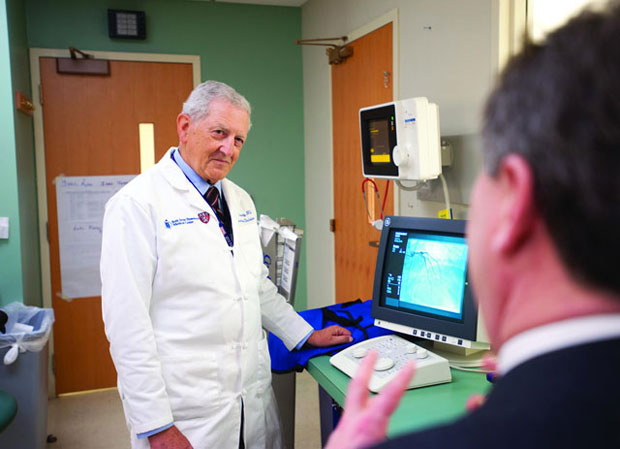In his eighties, retired cardiologist Julian Aroesty ’53 has a thriving second career as an expert witness
In his eighties, retired cardiologist Julian Aroesty ’53 has a thriving second career as an expert witness

The attorney was defending a cardiologist in a medical malpractice case, and he needed an expert witness with impressive credentials. That’s why he cold-called Julian Aroesty ’53, director of clinical cardiac catheterization at Boston’s Beth Israel Deaconess Hospital, an associate professor at Harvard Medical School, and a fixture on best-cardiologist lists in Boston Magazine and the Consumer’s Guide to Top Doctors.
Aroesty had never been an expert witness before. But after reviewing the medical chart and concurring that the doctor on trial was not at fault, he agreed. The cross-examination went on for a day and a half, as an experienced plaintiff’s attorney tried to discredit his testimony. But Aroesty was unflappable. “You are spectacular,” he recalls the defense attorney telling him. “I’ve never seen anyone keep her tied up in knots like this. You should think about doing this more often.”
That was fifteen years ago. As word of his prowess on the stand spread through the legal community, Aroesty found increasing demand for his medical expertise in the courtroom. He has since testified in more than fifty cases, mostly in Boston or New York, but as far away as Missouri. Since retiring from medical practice in December at age eighty, it’s become his second career.
Most of his work is for the defense. Of Aroesty’s forty-five or so defense cases, he’s lost only one, a success rate he partly attributes to the fact that he chooses his cases carefully. “When I’m sent a case, if I can’t support it firmly, I say so—‘settle it or send it to someone else,’” he says. “I don’t want to squirm on the stand. If I recommend settling, they usually do.”
Although he prefers defending doctors, Aroesty believes it’s unethical to say he won’t take a plaintiff’s case and has testified in a handful. “When plaintiff attorneys call me, I tell them I will review their case, but will go to court only if there’s something really egregious, i.e., this is someone I want to get out of the cath lab.” Aroesty cites the case of a drug-addicted physician who lost a patient while conducting a procedure under the influence. “The hospital had been trying to get rid of him for years,” says Aroesty. “We lost because we weren’t allowed to bring up his drug use, which the judge determined was unrelated to the matter. A year later he got caught trying to buy drugs from an undercover agent and went to prison.”
Aroesty prepares for a case by studying the medical chart and memorizing as much of it as possible, so it’s clear to the jury that he knows the facts inside and out. He reviews the medicine involved, reading all the latest related articles. “The expert for the opposing side is going to get the articles that support their case,” he says, “so you’ve got to know which ones they are and how you’re going to counter those facts,” he says. Although he understands why many physicians don’t enjoy the stress of being picked apart by opposing counsel, Aroesty views it as a challenge. “I love having this verbal war with the plaintiff’s attorneys, many of whom are very bright and have learned a fair amount of medicine in the course of their work,” he says. And because he loves to teach—having taught interventional cardiology to generations of medical students, residents, and fellows—he enjoys “educating” the jury. “I’m good at taking complicated material and simplifying it,” he says. “I make my own charts—I draw the heart within the chest and the coronary arteries, and show where the lesions are. I will often write out a table—all the things that support this doctor’s decision—on a large tablet. Then I advise the attorney to refer to that chart again during the summary so it’s firmly affixed in the jurors’ minds as they go to deliberate.”
'The lawyer is going to throw questions at you one after another and hope that you stumble and say something you shouldn’t have said.'It helps that Aroesty has no skeletons in his own closet. (“If you do,” he notes, “the opposing counsel is going to find them.”) During his fifty-year career, he established a reputation as one of the nation’s foremost interventional cardiologists, conducting 20,000 diagnostic cardiac catheterizations with only one death (the usual death rate is one per 1,000) and 2,000 angioplasties with no deaths, and producing dozens of publications on his clinical medical research. He was never sued. “I was extremely careful, and I trained people throughout all these procedures about the safest and most cautious way to do them,” says Aroesty.
He now shares the ins and outs of medical malpractice defense that he’s picked up as an expert witness. When he recently lectured on the topic as part of a Harvard Medical School continuing education course, it attracted 500 physicians from all over the country. “I share the tricks lawyers use, the things you have to do to defend yourself,” says Aroesty. “The lawyer is going to throw questions at you one after another and hope that you stumble and say something you shouldn’t have said. He’s going to try to speed you up; you try to slow him down. That throws off his pattern. When asked a question, deliberately think about it. Repeat the question: ‘Let me make sure I fully understand what you’re asking. Are you asking this?’ And then answer ‘yes,’ ‘no,’ or ‘I do not recall.’ If you give extra information, it will be used against you.”


